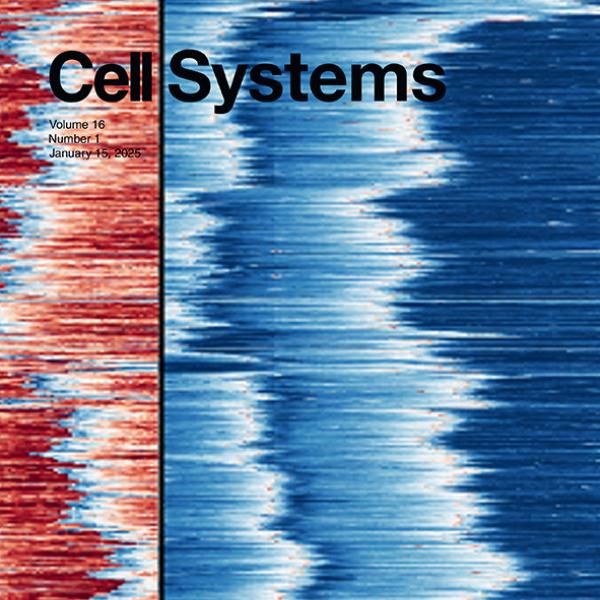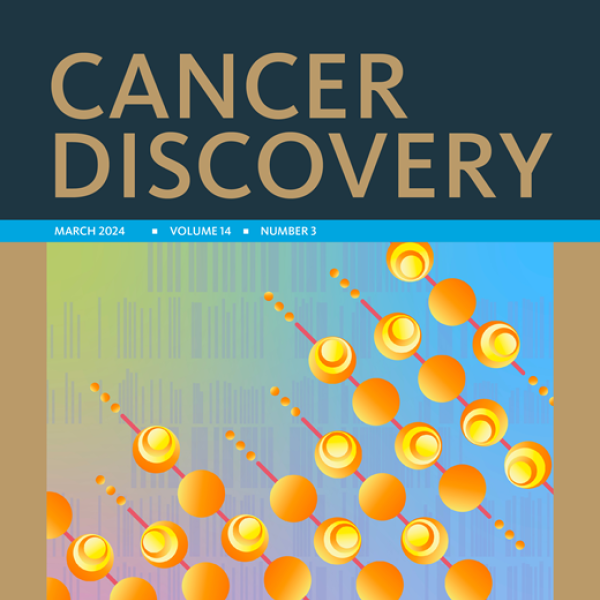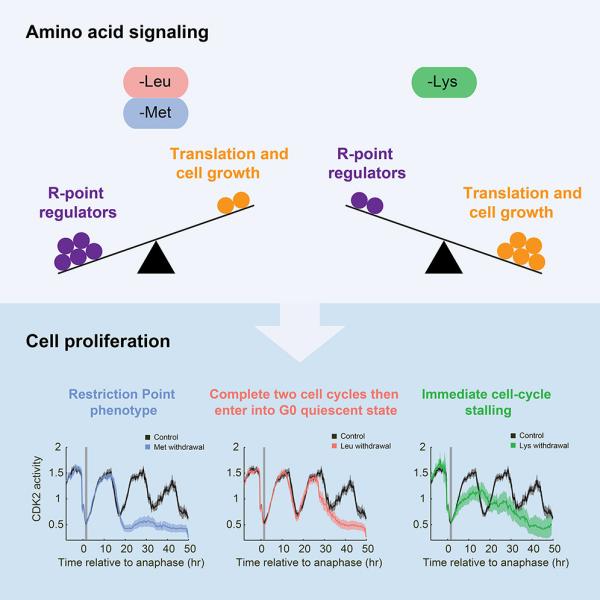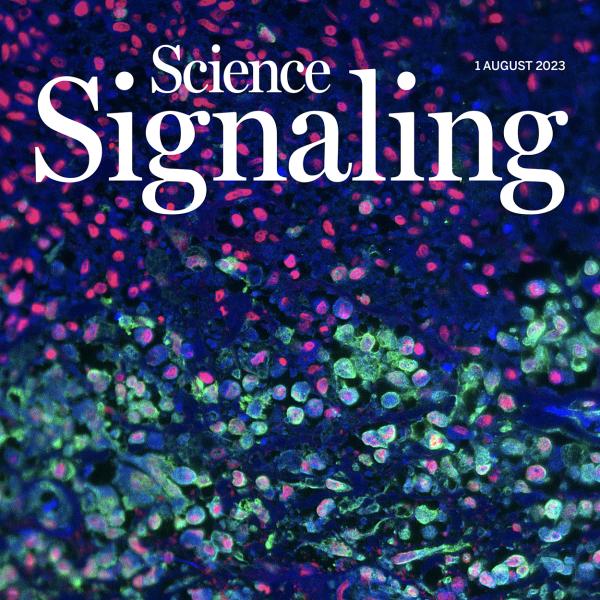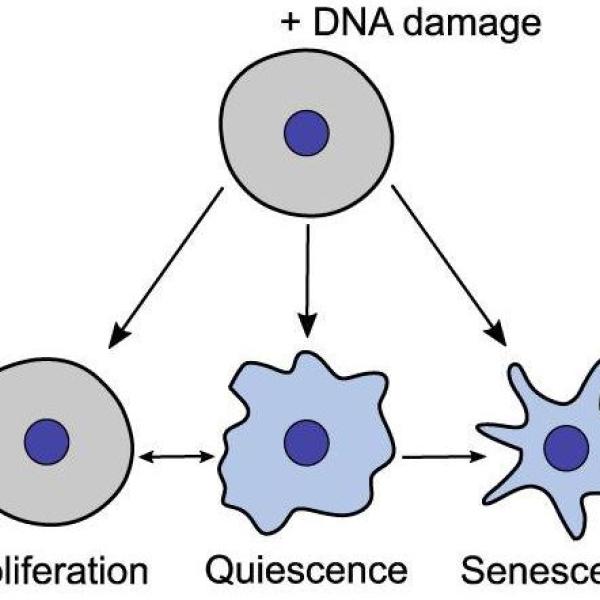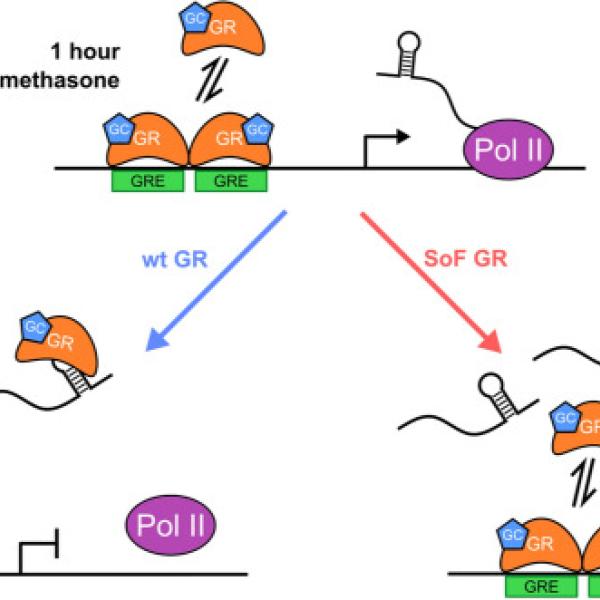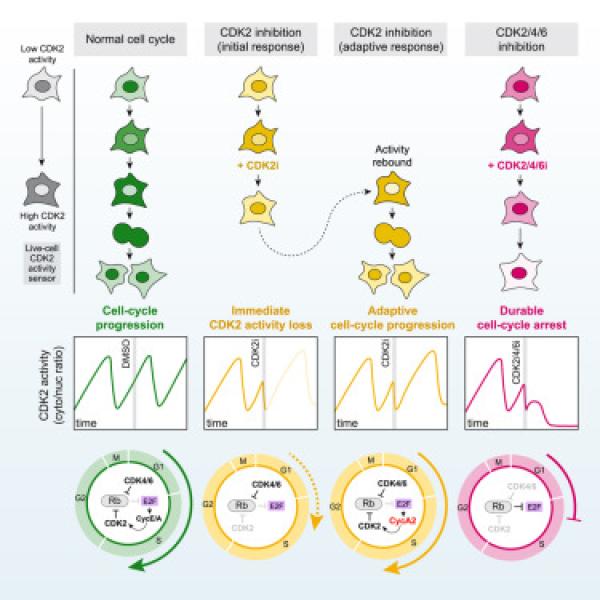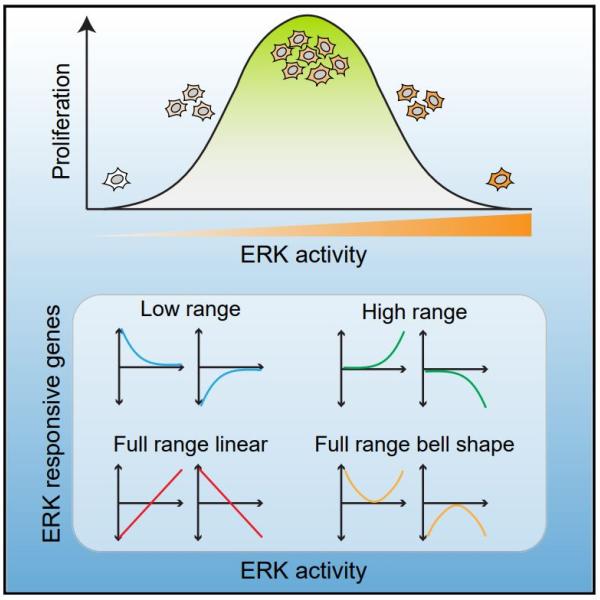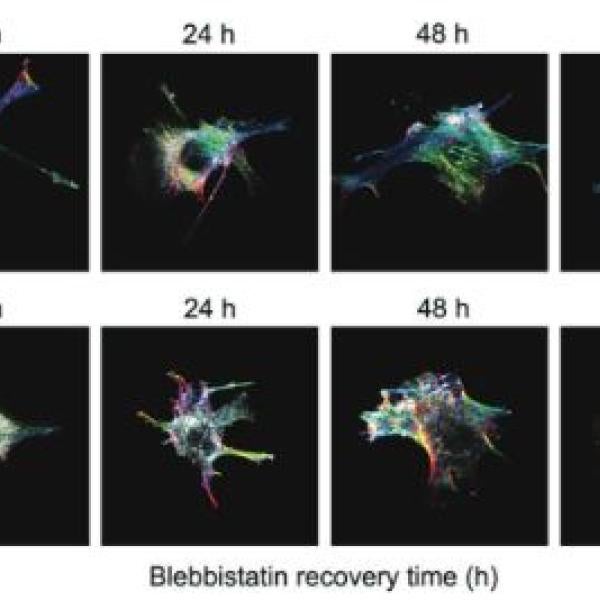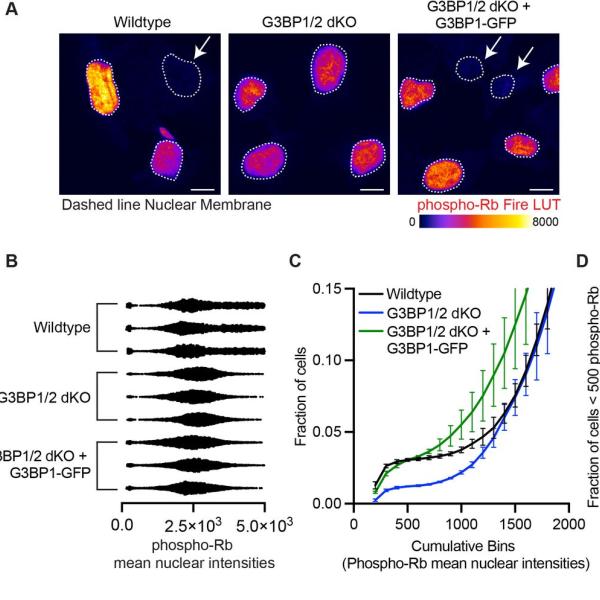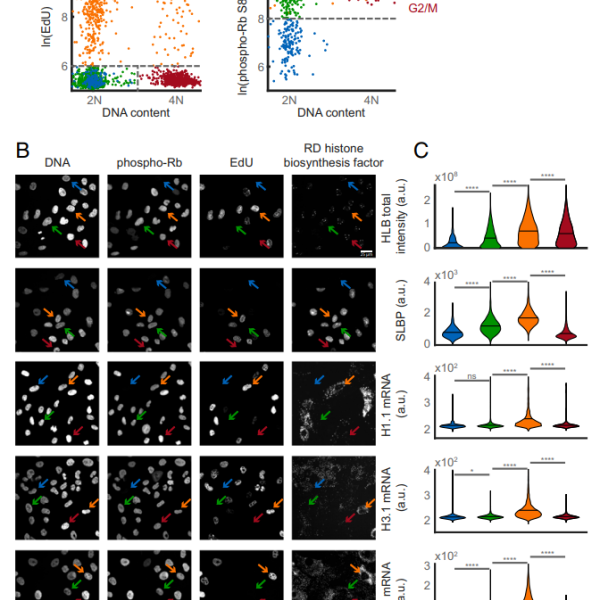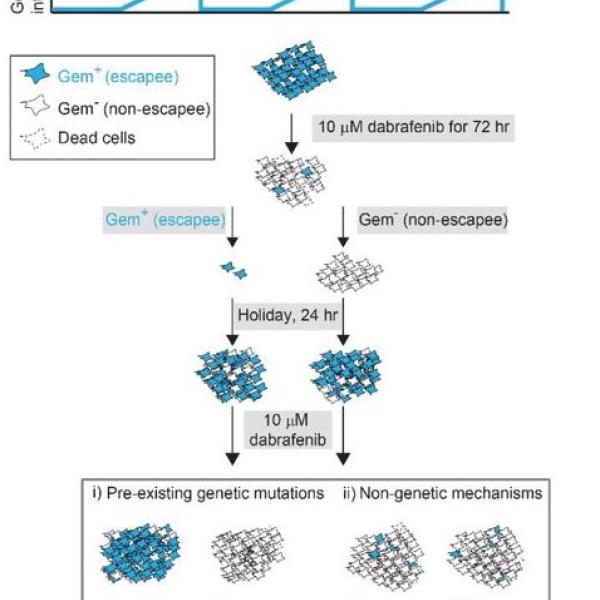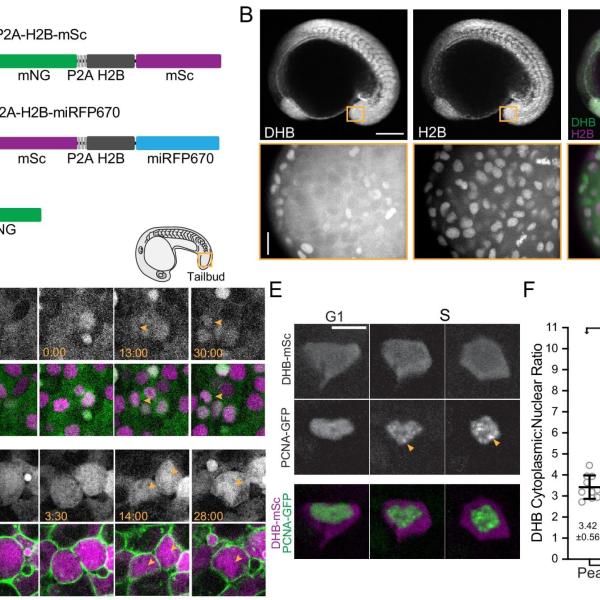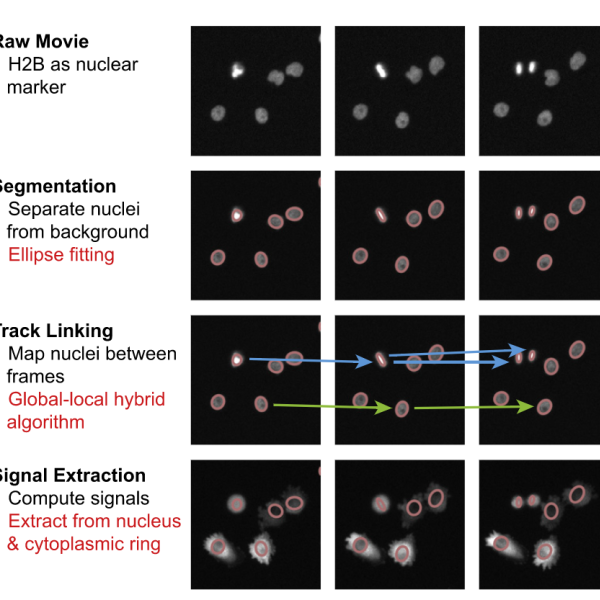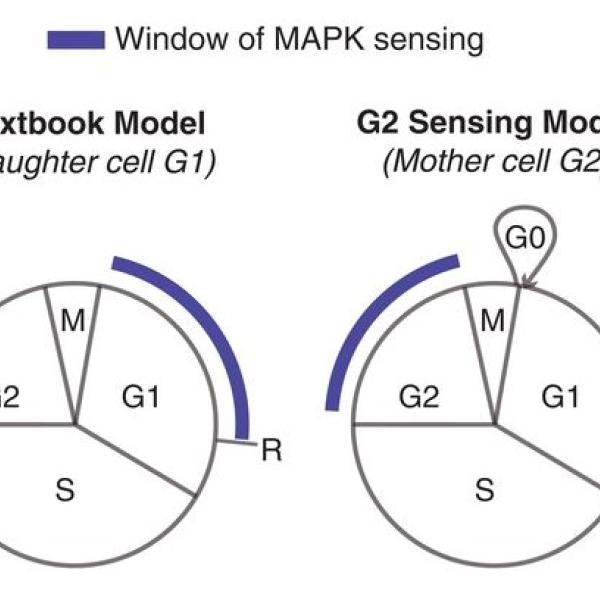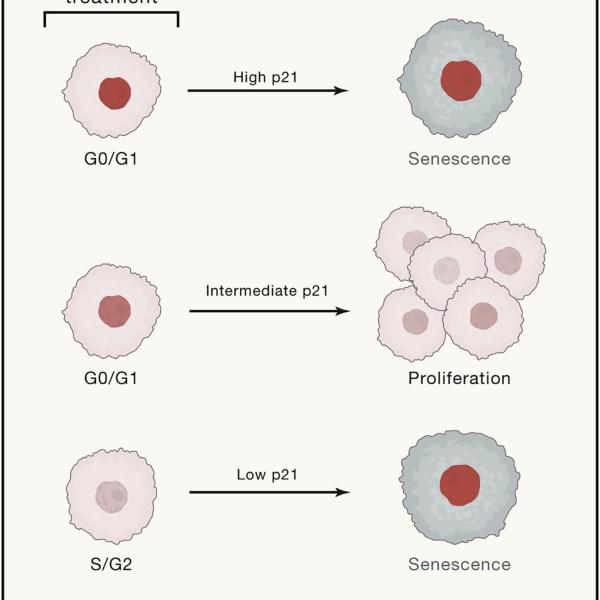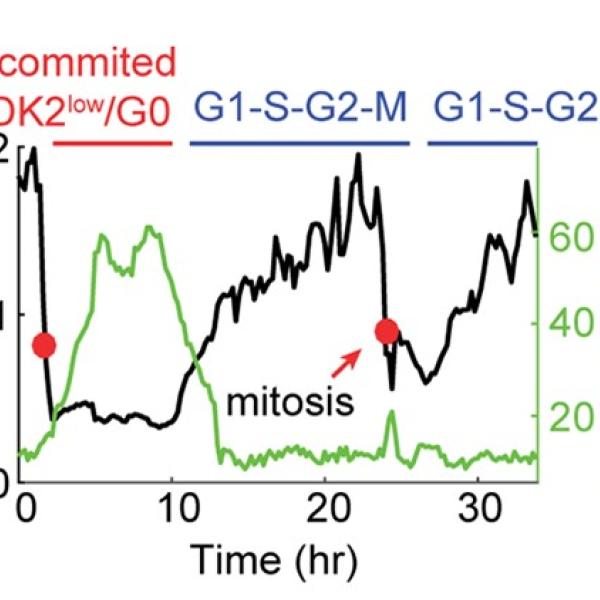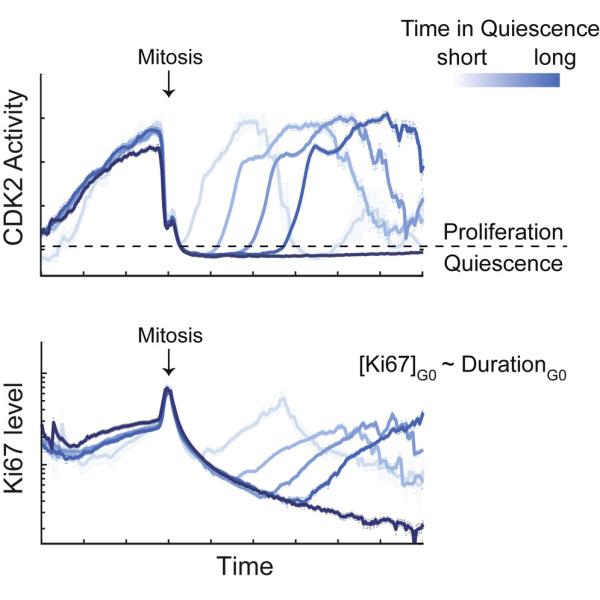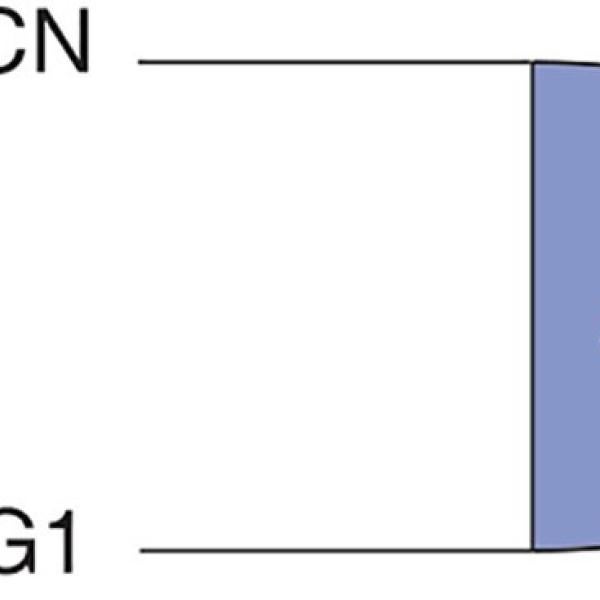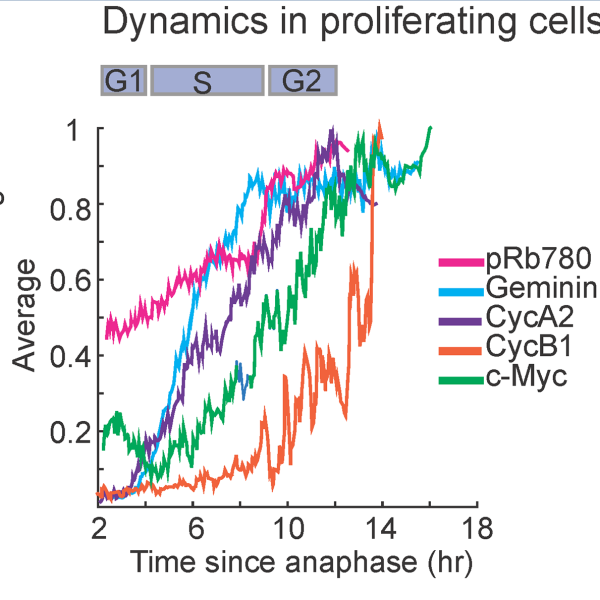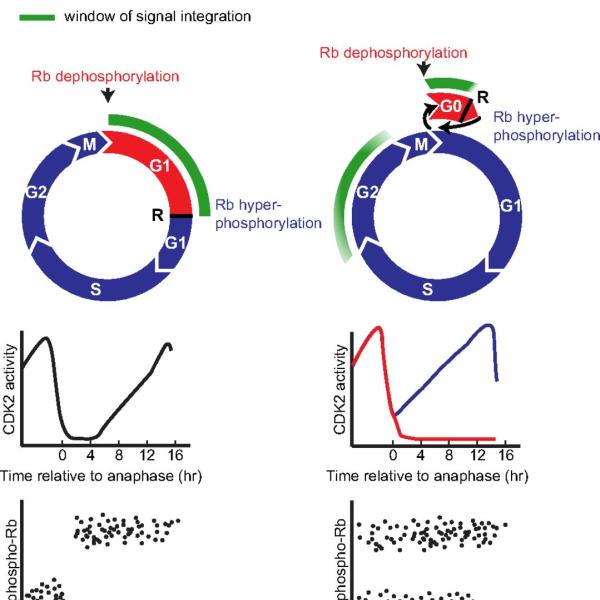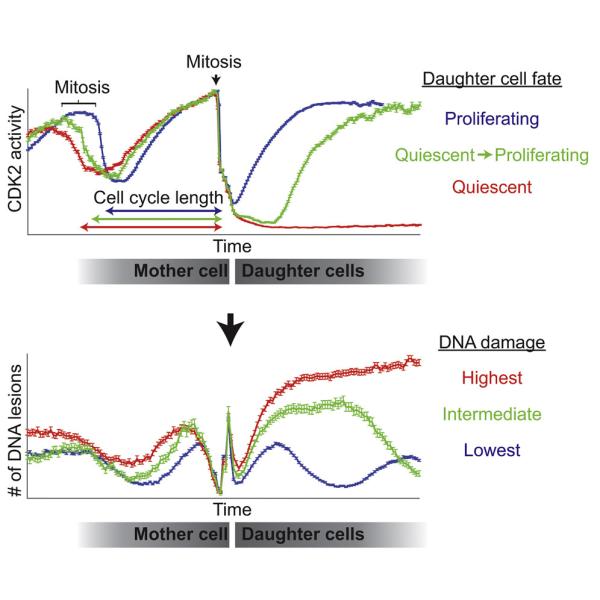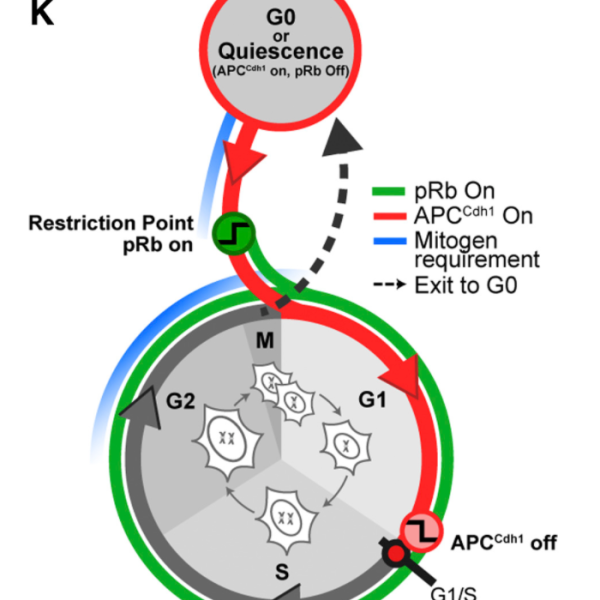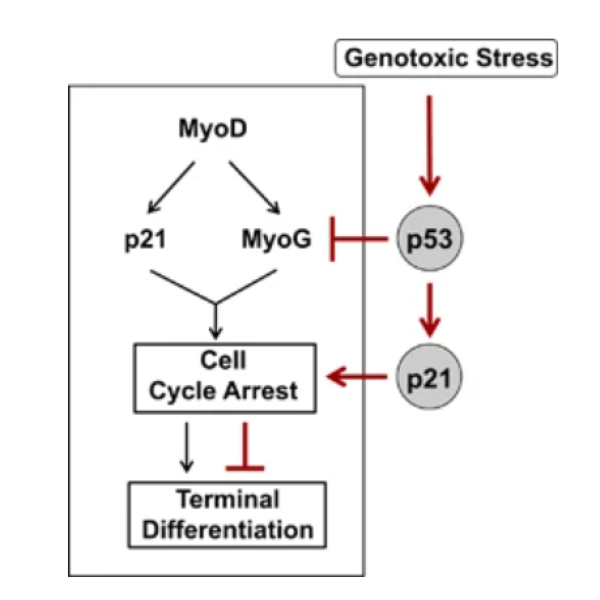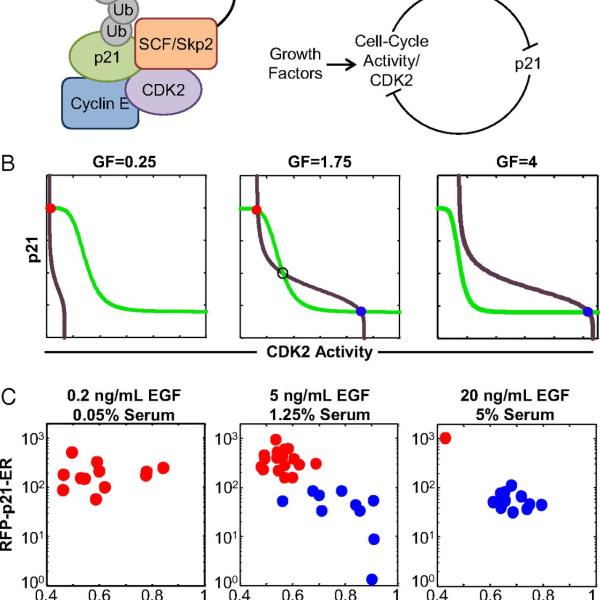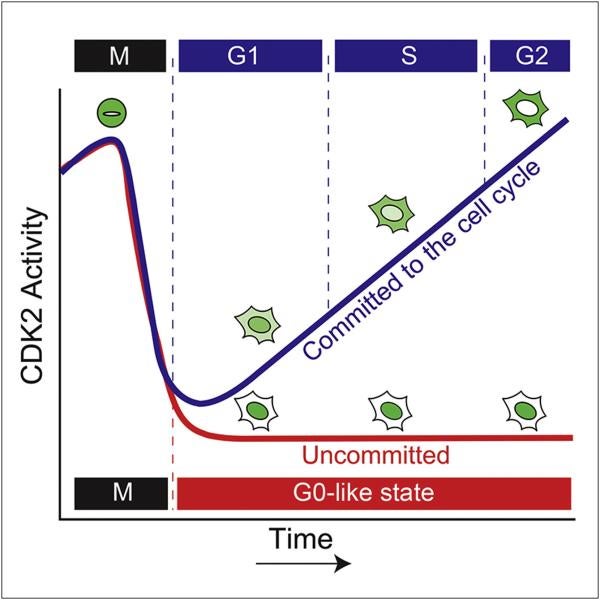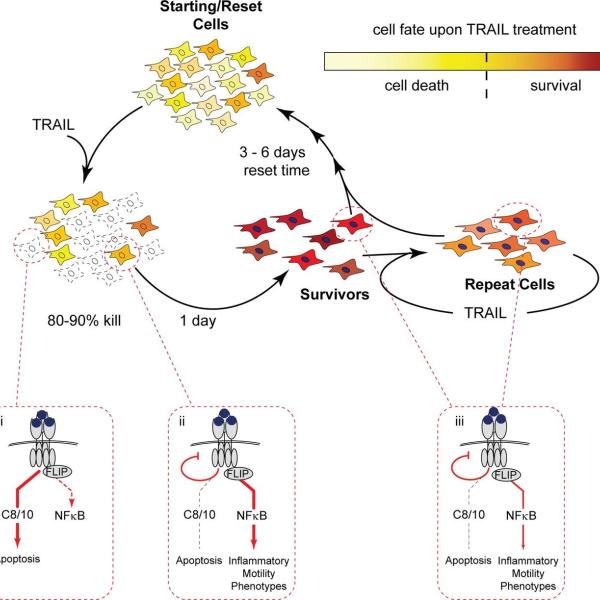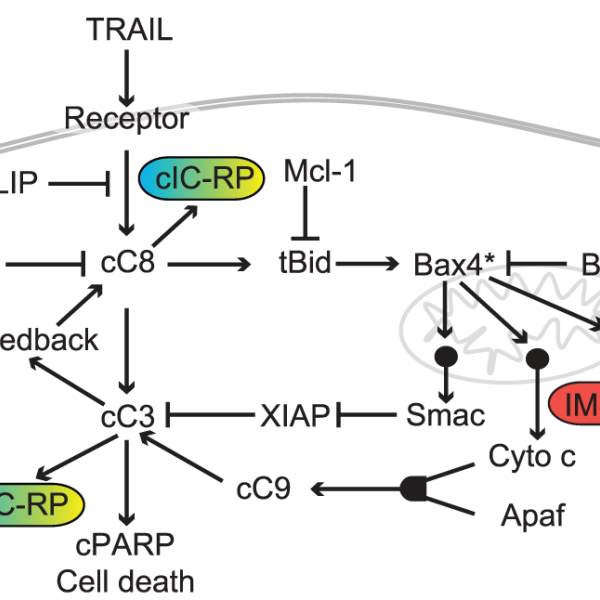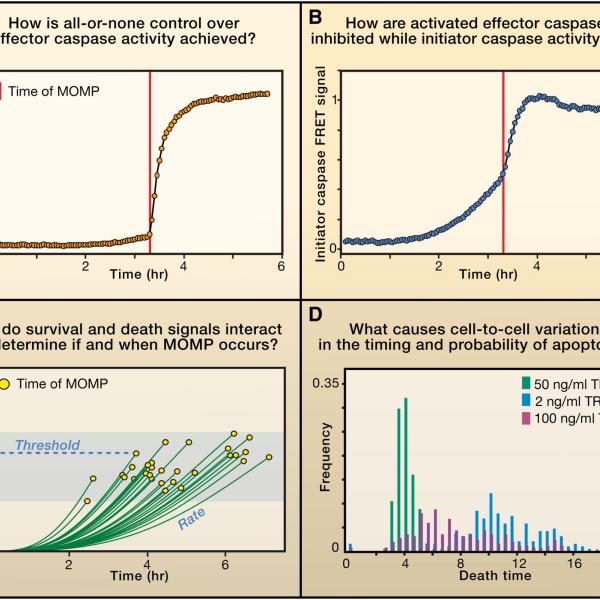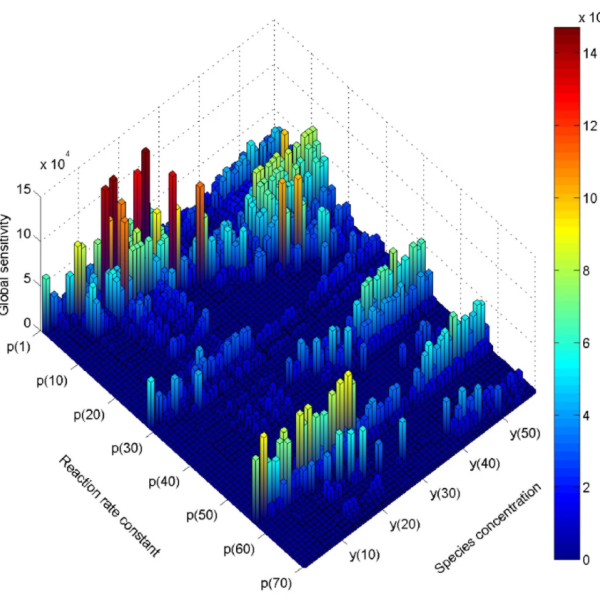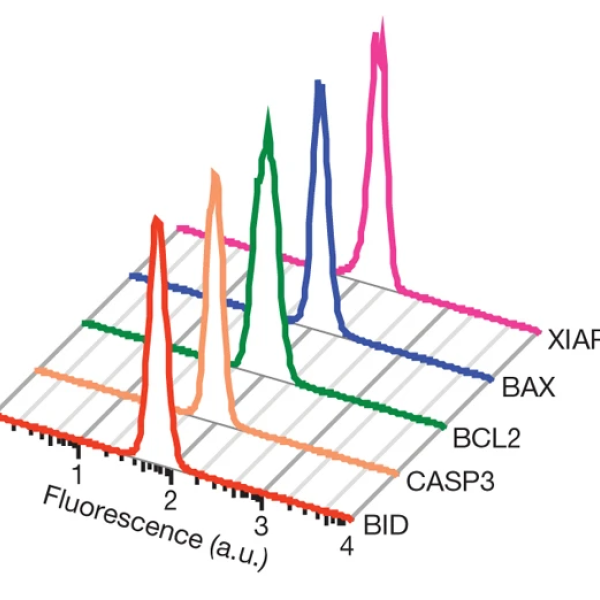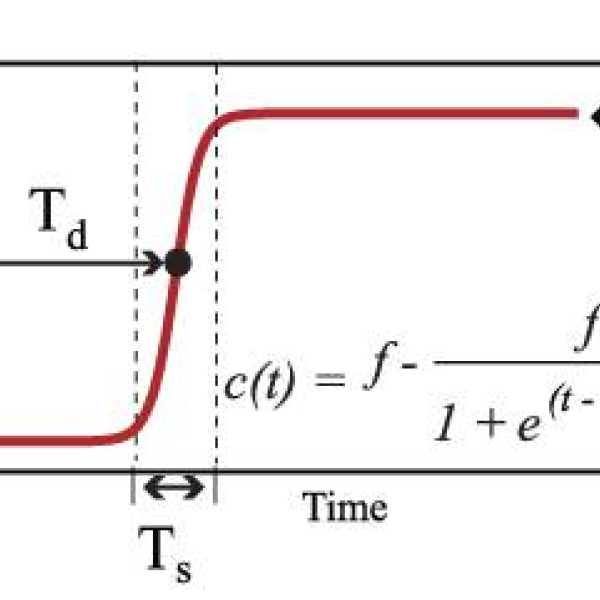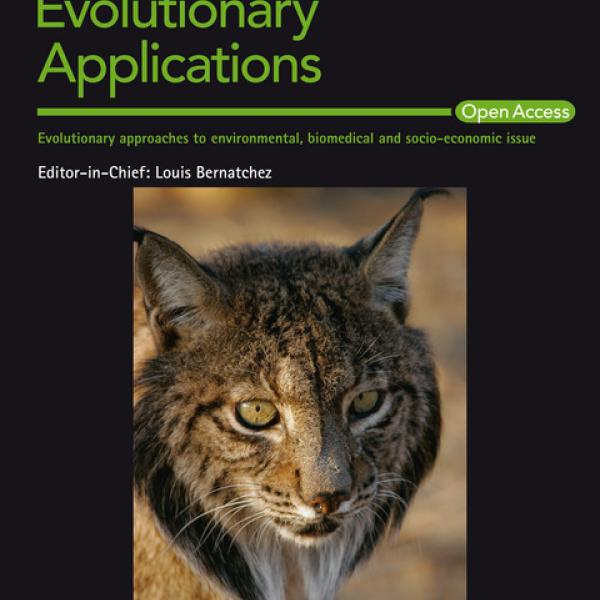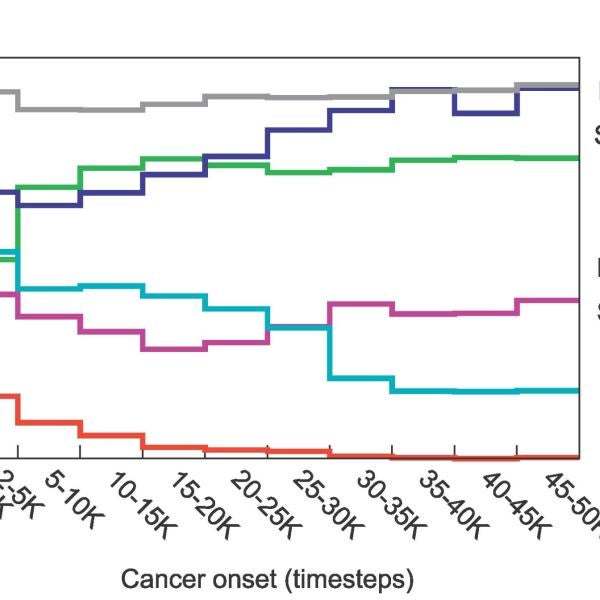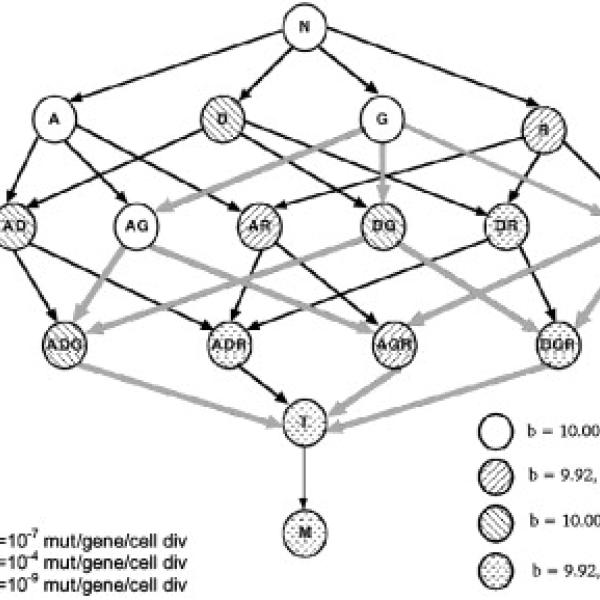Publications
MAPK and mTORC1 signaling converge to drive cyclin D1 protein production to enable cell cycle reentry in melanoma persister cells
In BRAF-mutant melanoma cells treated with inhibitors of the kinases BRAF and MEK, a subset of cells rapidly and nongenetically adapts to escape drug-induced quiescence and reenters the cell cycle. Here, we investigated the mechanisms enabling this drug escape by computationally reconstructing single-cell lineages from time-lapse imaging data, linking dynamic signaling pathways to distinct cell-cycle fate outcomes. We found that reactivation of the MEK substrate ERK was necessary but not sufficient to drive...
CDK2 activity crosstalk on the ERK kinase translocation reporter can be resolved computationally (Cell Systems 2025)
The mitogen-activated protein kinase (MAPK) pathway integrates growth factor signaling through extracellular signal-regulated kinase (ERK) to control cell proliferation. To study ERK dynamics, many researchers use an ERK activity kinase translocation reporter (KTR). Our study reveals that this ERK KTR also partially senses cyclin-dependent kinase 2 (CDK2) activity, making it appear as if ERK activity rises as cells progress through the cell cycle. Through single-cell time-lapse imaging, we identified a resi...
INX-315, a Selective CDK2 Inhibitor, Induces Cell Cycle Arrest and Senescence in Solid Tumors (Cancer Discovery 2024)
Cyclin-dependent kinase 2 (CDK2) is thought to play an important role in driving proliferation of certain cancers, including those harboringCCNE1amplification and breast cancers that have acquired resistance to CDK4/6 inhibitors (CDK4/6i). The precise impact of pharmacologic inhibition of CDK2 is not known due to the lack of selective CDK2 inhibitors. Here we describe INX-315, a novel and potent CDK2 inhibitor with high selectivity over other CDK family members. Using cell-based assays, patient-derived xeno...
Cells use multiple mechanisms for cell-cycle arrest upon withdrawal of individual amino acids (Cell Reports 2023)
Amino acids are required for cell growth and proliferation, but it remains unclear when and how amino acid availability impinges on the proliferation-quiescence decision. Here, we used time-lapse microscopy and single-cell tracking of cyclin-dependent kinase 2 (CDK2) activity to assess the response of individual cells to withdrawal of single amino acids and found strikingly different cell-cycle effects depending on the amino acid. For example, upon leucine withdrawal, MCF10A cells complete two cell cycles a...
Multiple cancers escape from multiple MAPK pathway inhibitors and use DNA replication stress signaling to tolerate aberrant cell cycles (Science Signaling 2023)
Many cancers harbor pro-proliferative mutations of the mitogen-activated protein kinase (MAPK) pathway. In BRAF-driven melanoma cells treated with BRAF inhibitors, subpopulations of cells escape drug-induced quiescence through a nongenetic manner of adaptation and resume slow proliferation. Here, we found that this phenomenon is common to many cancer types driven by EGFR, KRAS, or BRAF mutations in response to multiple, clinically approved MAPK pathway inhibitors. In 2D cultures and 3D spheroid models of va...
The intensities of canonical senescence biomarkers integrate the duration of cell-cycle withdrawal (Nature Communications 2023)
Senescence, a state of permanent cell-cycle withdrawal, is difficult to distinguish from quiescence, a transient state of cell-cycle withdrawal. This difficulty arises because quiescent and senescent cells are defined by overlapping biomarkers, raising the question of whether quiescence and senescence are truly distinct states. To address this, we used single-cell time-lapse imaging to distinguish slow-cycling quiescent cells frombona fidesenescent cells after chemotherapy treatment, followed immediately by...
RNA binding by the glucocorticoid receptor attenuates dexamethasone-induced gene activation (Scientific Reports 2023)
The glucocorticoid receptor (GR) is a ligand-activated transcription factor that regulates a suite of genes through direct binding of GR to specific DNA promoter elements. GR also interacts with RNA, but the function of this RNA-binding activity remains elusive. Current models speculate that RNA could repress the transcriptional activity of GR. To investigate the function of the GR-RNA interaction on GR's transcriptional activity, we generated cells that stably express a mutant of GR with reduced RNA bindin...
Rapid adaptation to CDK2 inhibition exposes intrinsic cell-cycle plasticity (Cell 2023)
CDK2 is a core cell-cycle kinase that phosphorylates many substrates to drive progression through the cell cycle. CDK2 is hyperactivated in multiple cancers and is therefore an attractive therapeutic target. Here, we use several CDK2 inhibitors in clinical development to interrogate CDK2 substrate phosphorylation, cell-cycle progression, and drug adaptation in preclinical models. Whereas CDK1 is known to compensate for loss of CDK2 inCdk2−/−mice, this is not true of acute inhibition of CDK2. Upon CDK2 inhib...
Multi-range ERK responses shape the proliferative trajectory of single cells following oncogene induction (Cell Reports 2023)
Oncogene-induced senescence is a phenomenon in which aberrant oncogene expression causes non-transformed cells to enter a non-proliferative state. Cells undergoing oncogenic induction display phenotypic heterogeneity, with some cells senescing and others remaining proliferative. The causes of heterogeneity remain unclear. We studied the sources of heterogeneity in the responses of human epithelial cells to oncogenic BRAFV600Eexpression. We found that a narrow expression range of BRAFV600Egenerated a wide ra...
Intracellular Crowding by Bio-Orthogonal Hydrogel Formation Induces Reversible Molecular Stasis (Advanced Materials 2022)
To survive extreme conditions, certain animals enter a reversible protective stasis through vitrification of the cytosol by polymeric molecules such as proteins and polysaccharides. In this work, synthetic gelation of the cytosol in living cells is used to induce reversible molecular stasis. Through the sequential lipofectamine-mediated transfection of complementary poly(ethylene glycol) macromers into mammalian cells, intracellular crosslinking occurs through bio-orthogonal strain-promoted azide–alkyne cyc...
Stress granules promote chemoresistance by triggering cellular quiescence (bioRxiv 2022)
Cells respond to cellular stress by forming stress granules, molecular condensates containing non-translating messenger ribonucleoproteins. Stress granules form during chemotherapy and promote cell survival and chemoresistance, although the mechanism of this effect is not understood. We provide several lines of evidence that stress granules enhance cell survival by promoting cellular quiescence. First, we see a correlation between spontaneous stress granule formation and cell-cycle exit under non-stress con...
Replication-dependent histone biosynthesis is coupled to cell-cycle commitment (PNAS 2021)
The current model of replication-dependent (RD) histone biosynthesis posits that RD histone gene expression is coupled to DNA replication, occurring only in S phase of the cell cycle once DNA synthesis has begun. However, several key factors in the RD histone biosynthesis pathway are up-regulated by E2F or phosphorylated by CDK2, suggesting these processes may instead begin much earlier, at the point of cell-cycle commitment. In this study, we use both fixed- and live-cell imaging of human cells to address ...
Melanoma subpopulations that rapidly escape MAPK pathway inhibition incur DNA damage and rely on stress signalling (Nature Communications 2021)
Despite the increasing number of effective anti-cancer therapies, successful treatment is limited by the development of drug resistance. While the contribution of genetic factors to drug resistance is undeniable, little is known about how drug-sensitive cells first evade drug action to proliferate in drug. Here we track the responses of thousands of single melanoma cells to BRAF inhibitors and show that a subset of cells escapes drug via non-genetic mechanisms within the first three days of treatment. Cells...
Visualizing the metazoan proliferation-quiescence decision in vivo (eLife 2020)
Cell proliferation and quiescence are intimately coordinated during metazoan development. Here, we adapt a cyclin-dependent kinase (CDK) sensor to uncouple these key events of the cell cycle inCaenorhabditis elegansand zebrafish through live-cell imaging. The CDK sensor consists of a fluorescently tagged CDK substrate that steadily translocates from the nucleus to the cytoplasm in response to increasing CDK activity and consequent sensor phosphorylation. We show that the CDK sensor can distinguish cycling c...
EllipTrack: A Global-Local Cell-Tracking Pipeline for 2D Fluorescence Time-Lapse Microscopy (Cell Reports 2020)
Time-lapse microscopy provides an unprecedented opportunity to monitor single-cell dynamics. However, tracking cells for long periods remains a technical challenge, especially for multi-day, large-scale movies with rapid cell migration, high cell density, and drug treatments that alter cell morphology/behavior. Here, we present EllipTrack, a global-local cell-tracking pipeline optimized for tracking such movies. EllipTrack first implements a global track-linking algorithm to construct tracks that maximize t...
Temporal integration of mitogen history in mother cells controls proliferation of daughter cells (Science 2020)
Multicellular organisms use mitogens to regulate cell proliferation, but how fluctuating mitogenic signals are converted into proliferation-quiescence decisions is poorly understood. In this work, we combined live-cell imaging with temporally controlled perturbations to determine the time scale and mechanisms underlying this system in human cells. Contrary to the textbook model that cells sense mitogen availability only in the G1cell cycle phase, we find that mitogenic signaling is temporally integrated thr...
Senescence Evasion in Chemotherapy: A Sweet Spot for p21 (Cell 2019)
Time-lapse imaging reveals a nuanced role forp21in cancer cells challenged with chemotherapeutic drugs: cells with either high or low p21 are biased toward senescence, whereas intermediate p21 allows cells to re-enter the cell cycle after drug treatment. [Article Link]
Spontaneously slow-cycling subpopulations of human cells originate from activation of stress-response pathways (PLOS Biology 2019)
Slow-cycling subpopulations exist in bacteria, yeast, and mammalian systems. In the case of cancer, slow-cycling subpopulations have been proposed to give rise to drug resistance. However, the origin of slow-cycling human cells is poorly studied, in large part due to lack of markers to identify these rare cells. Slow-cycling cells pass through a noncycling period marked by low CDK2 activity and high p21 levels. Here, we use this knowledge to isolate these naturally slow-cycling cells from a heterogeneous po...
Ki67 is a Graded Rather than a Binary Marker of Proliferation versus Quiescence (Cell Reports 2018)
Ki67 staining is widely used as a proliferation indicator in the clinic, despite poor understanding of this protein’s function or dynamics. Here, we track Ki67 levels under endogenous control in single cells over time and find that Ki67 accumulation occurs only during S,G2, and M phases. Ki67 is degraded continuously inG1 and G0 phases, regardless of the cause of entry into G0/quiescence. Consequently, the level of Ki67 during G0 and G1 in individual cells is highly heterogeneous and depends on how long an ...
A Cell-Cycle “Safe Space” for Surviving Chemotherapy (Cell Systems 2017)
Live-cell imaging demonstrates that a subset of neuroblastoma cells evades chemotherapy-induced death if they are in early G1 phase of the cell cycle at the time of drug treatment and have sufficiently high levels of MYCN.Chemotherapy remains the first line of treatment for most cancers. However, tumors often become refractory to these treatments, referred to as chemoresistance. Resistance and relapse are generally attributed to heterogeneity in drug response, wherein a subset of cells are less susceptible ...
A map of protein dynamics during cell-cycle progression and cell-cycle exit (PLOS Biology 2017)
The cell-cycle field has identified the core regulators that drive the cell cycle, but we do not have a clear map of the dynamics of these regulators during cell-cycle progression versus cell-cycle exit. Here we use single-cell time-lapse microscopy of Cyclin-Dependent Kinase 2 (CDK2) activity followed by endpoint immunofluorescence and computational cell synchronization to determine the temporal dynamics of key cell-cycle proteins in asynchronously cycling human cells. We identify several unexpected patter...
Control of the Restriction Point by Rb and p21 (PNAS 2017)
The Restriction Point was originally defined as the moment that cells commit to the cell cycle and was later suggested to coincide with hyperphosphorylation of the retinoblastoma protein (Rb). Current cell cycle models posit that cells exit mitosis into a pre-Restriction Point state, where they have low cyclin-dependent kinase (CDK) activity and hypophosphorylated Rb; passage through the Restriction Point then occurs in late G1. Recent single-cell studies have challenged the current paradigm, raising questi...
Endogenous Replication Stress in Mother Cells Leads to Quiescence of Daughter Cells (Cell Reports 2017)
Mammalian cellshave two fundamentally different states, proliferative and quiescent, but our understanding of how and why cells switch between these states is limited. We previously showed that actively proliferating populations contain a subpopulation that enters quiescence (G0) in an apparently stochastic manner. Using single-cell time-lapse imaging of CDK2 activity and DNA damage, we now show that unresolved endogenous replication stress in the previous (mother) cell cycle prompts p21-dependent entry of ...
Irreversible APCCdh1 inactivation underlies the point of no return for cell-cycle entry (Cell 2016)
Proliferating cellsmust cross a point of no return before they replicate their DNA and divide. This commitment decision plays a fundamental role in cancer and degenerative diseases and has been proposed to be mediated by phosphorylation ofretinoblastoma(Rb) protein. Here, we show that inactivation of the anaphase-promoting complex/cyclosome (APCCdh1) has the necessary characteristics to be the point of no return for cell-cycle entry. Our study shows that APCCdh1inactivation is a rapid, bistable switch initi...
p53 suppresses muscle differentiation at the myogenin step in response to genotoxic stress (Cell Death & Differentiation 2015)
Acute muscle injury and physiological stress from chronic muscle diseases and aging lead to impairment of skeletal muscle function. This raises the question of whether p53, a cellular stress sensor, regulates muscle tissue repair under stress conditions. By investigating muscle differentiation in the presence of genotoxic stress, we discovered that p53 binds directly to the myogenin promoter and represses transcription of myogenin, a member of the MyoD family of transcription factors that plays a critical r...
Basal p21 controls population heterogeneity in cycling and quiescent cell cycle states (PNAS 2014)
Phenotypic heterogeneity within a population of genetically identical cells is emerging as a common theme in multiple biological systems, including human cell biology and cancer. Using live-cell imaging, flow cytometry, and kinetic modeling, we showed that two states—quiescence and cell cycling—can coexist within an isogenic population of human cells and resulted from low basal expression levels of p21, a Cyclin-dependent kinase (CDK) inhibitor (CKI). We attribute the p21-dependent heterogeneity in cell cyc...
The Proliferation-Quiescence Decision Is Controlled by a Bifurcation in CDK2 Activity at Mitotic Exit (Cell 2013)
Tissuehomeostasisin metazoans is regulated by transitions of cells between quiescence and proliferation. The hallmark of proliferating populations is progression through the cell cycle, which is driven bycyclin-dependent kinase(CDK) activity. Here, we introduce a live-cell sensor for CDK2 activity and unexpectedly found thatproliferating cellsbifurcate into two populations as they exit mitosis. Many cells immediately commit to the next cell cycle by building up CDK2 activity from an intermediate level, whil...
Cells surviving fractional killing by TRAIL exhibit transient but sustainable resistance and inflammatory phenotypes (Molecular Biology of the Cell 2013)
When clonal populations of human cells are exposed to apoptosis-inducing agents, some cells die and others survive. This fractional killing arises not from mutation but from preexisting, stochastic differences in the levels and activities of proteins regulating apoptosis. Here we examine the properties of cells that survive treatment with agonists of two distinct death receptors, tumor necrosis factor–related apoptosis-inducing ligand (TRAIL) and anti-FasR antibodies. We find that “survivor” cells are highl...
Exploring the contextual sensitivity of factors that determine cell-to-cell variability in receptor-mediated apoptosis (PLOS Computational Biology 2012)
Stochastic fluctuations in gene expression give rise to cell-to-cell variability in protein levels which can potentially cause variability in cellular phenotype. For TRAIL (TNF-related apoptosis-inducing ligand) variability manifests itself as dramatic differences in the time between ligand exposure and the sudden activation of the effector caspases that kill cells. However, the contribution of individual proteins to phenotypic variability has not been explored in detail. In this paper we use feature-based ...
Measuring and Modeling Apoptosis in Single Cells (Cell 2011)
Cell death plays an essential role in the development of tissues and organisms, the etiology of disease, and the responses of cells to therapeutic drugs. Here we review progress made over the last decade in using mathematical models and quantitative, often single-cell, data to study apoptosis. We discuss the delay that follows exposure of cells to prodeath stimuli, control ofmitochondrial outer membranepermeabilization, switch-like activation of effectorcaspases, and variability in the timing and probabilit...
Systematic calibration of a cell signaling network model (BMC Bioinformatics 2010)
Mathematical modeling is being applied to increasingly complex biological systems and datasets; however, the process of analyzing and calibrating against experimental data is often challenging and a rate limiting step in model development. To address this problem, we developed a systematic methodology for calibrating quantitative models of dynamic biological processes and illustrate its utility by validating a model of TRAIL (Tumor necrosis factor Related Apoptosis-Inducing Ligand)-induced cell death. [Arti...
Non-genetic cell-to-cell variability and the consequences for pharmacology (Current Opinion in Chemical Biology 2009)
Recent advances in single-cell assays have focused attention on the fact that even members of a genetically identical group of cells or organisms in identical environments can exhibit variability in drug sensitivity, cellular response, and phenotype. Underlying much of this variability is stochasticity in gene expression, which can produce unique proteomes even in genetically identical cells. Here we discuss the consequences of non-genetic cell-to-cell variability in the cellular response to drugs and its p...
Non-genetic origins of cell-to-cell variability in TRAIL-induced apoptosis (Nature 2009)
In microorganisms, noise in gene expression gives rise to cell-to-cell variability in protein concentrations1,2,3,4,5,6,7. In mammalian cells, protein levels also vary8,9,10and individual cells differ widely in their responsiveness to uniform physiological stimuli11,12,13,14,15. In the case of apoptosis mediated by TRAIL (tumour necrosis factor (TNF)-related apoptosis-inducing ligand) it is common for some cells in a clonal population to die while others survive—a striking divergence in cell fate. Among cel...
Modeling a snap-action, variable-delay switch controlling extrinsic cell death (PLOS Biology 2008)
When exposed to tumor necrosis factor (TNF) or TNF-related apoptosis-inducing ligand (TRAIL), a closely related death ligand and investigational therapeutic, cells enter a protracted period of variable duration in which only upstream initiator caspases are active. A subsequent and sudden transition marks activation of the downstream effector caspases that rapidly dismantle the cell. Thus, extrinsic apoptosis is controlled by an unusual variable-delay, snap-action switch that enforces an unambiguous choice b...
Cancer research meets evolutionary biology (Evolutionary Applications 2009)
There is increasing evidence that Darwin's theory of evolution by natural selection provides insights into the etiology and treatment of cancer. On a microscopic scale, neoplastic cells meet the conditions for evolution by Darwinian selection: cell reproduction with heritable variability that affects cell survival and replication. This suggests that, like other areas of biological and biomedical research, Darwinian theory can provide a general framework for understanding many aspects of cancer, including pr...
Modeling somatic evolution in tumorigenesis (PLOS Computational Biology 2006)
Tumorigenesis in humans is thought to be a multistep process where certain mutations confer a selective advantage, allowing lineages derived from the mutated cell to outcompete other cells. Although molecular cell biology has substantially advanced cancer research, our understanding of the evolutionary dynamics that govern tumorigenesis is limited. This paper analyzes the computational implications of cancer progression presented by Hanahan and Weinberg in The Hallmarks of Cancer. We model the complexities ...
An ordinary differential equation model for the multistep transformation to cancer Authors (Journal of Theoretical Biology 2004)
Cancer is viewed as a multistep process whereby a normal cell is transformed into a cancer cell through the acquisition of mutations. We reduce the complexities of cancer progression to a simple set of underlying rules that govern the transformation of normal cells to malignant cells. In doing so, we derive an ordinary differential equation model that explores how the balance ofangiogenesis, cell death rates, genetic instability, and replication rates give rise to different kinetics in the development of ca...



